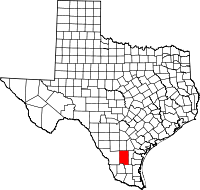Duval County, Texas
| Duval County, Texas | |
|---|---|

The Duval County Courthouse in San Diego
|
|
 Location in the U.S. state of Texas |
|
 Texas's location in the U.S. |
|
| Founded | 1876 |
| Named for | Burr H. Duval |
| Seat | San Diego |
| Largest city | San Diego |
| Area | |
| • Total | 1,796 sq mi (4,652 km2) |
| • Land | 1,793 sq mi (4,644 km2) |
| • Water | 2.1 sq mi (5 km2), 0.1% |
| Population | |
| • (2010) | 11,782 |
| • Density | 6.6/sq mi (3/km²) |
| Congressional district | 15th |
| Time zone | Central: UTC-6/-5 |
| Website | www |
Duval County is a county located in the U.S. state of Texas. As of the 2010 census, its population was 11,782. The county seat is San Diego. The county was founded in 1858 and later organized in 1876. It is named for Burr H. Duval, a soldier in the Texas Revolution who died in the Goliad Massacre.
Even though Duval County lies in the United States, it has long been Mexican in character. A Mexican first surveyed it in 1804, Jose Contrerras, surveyor general of San Luis Potosi. Luis Muniz was born there in 1828, the county's first recorded birth. The important colonists came from Mier, Tamaulipas - and Anglos later respected their descendants as the old Mexican families.
The Texas Legislature established Duval County February 1, 1858. The Texas Almanac of 1867 reported that Duval and nearby Dimmit County had only four stock raisers and their population was unlikely to grow much absent the discovery of mineral wealth. Not long after, a wave of Anglo immigrants entered the county to raise sheep. Englishmen, Frenchmen, Germans, Irishmen, and Scots came. During this boom, the county seat enjoyed formal balls and haute cuisine. The Hotel Martinet's Sunday feast drew patrons from Corpus Christi, 50 miles (80 km) to the East. The death rate rivaled Tombstone, Arizona's. Some died under the code duello but more by foul play; the victims were usually Mexican. A vigilante group from Duval and McMullen County found a great pile of cowhides (presumably from stolen animals) near the county line; they lynched 15 Mexicans there. Prosperity in the 1880s eased ethnic animosities. After the Texas-Mexican Railway was built in 1881, its San Diego station was important for hides, wool, and cotton. But in 1886 the sheep began to die, and the boom died.
...
Wikipedia
